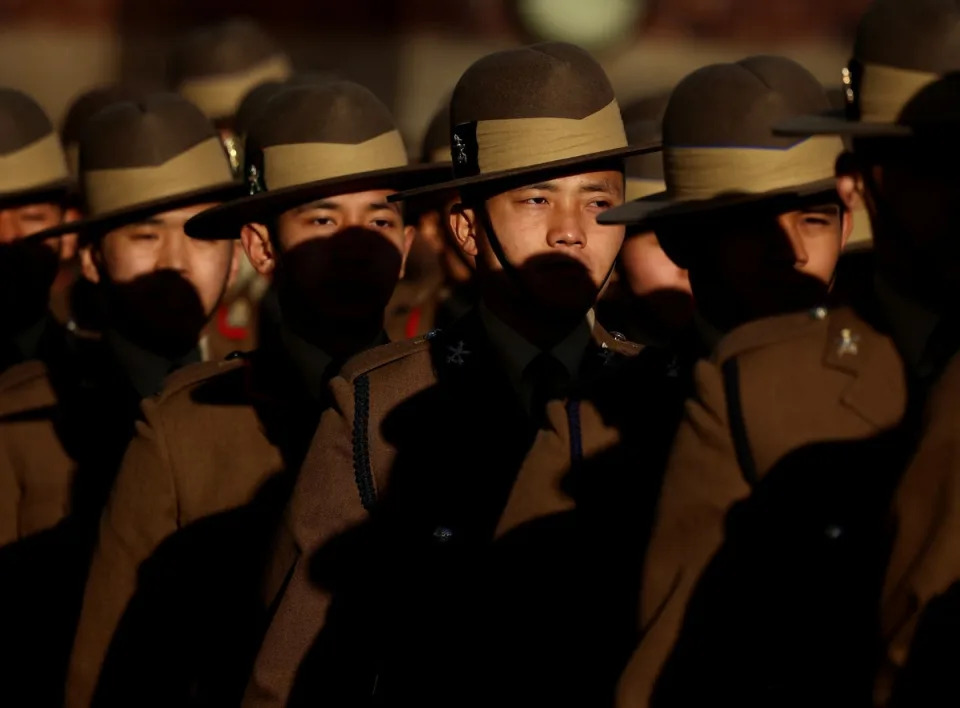'A total farce': Labour furious as govt reveals cost of Rwanda policy
Sky News
Updated Thu, 7 December 2023

Rishi Sunak is facing fresh pressure over his Rwanda policy after it emerged the scheme has already cost £240m, despite never being used.
The government spent a further £100m in the 2023-24 financial year while flights remained grounded amid a series of legal setbacks - on top of the £140m previously paid out.
According to a letter from the Home Office to committee chairs, ministers expect additional costs of £50m in the coming year, which would bring the total to £290m.
It comes just hours after Mr Sunak vowed to "finish the job" of reviving his plan to deport some asylum seekers to Kigali - despite the prospect of a bitter parliamentary battle.
Home Office official Matthew Rycroft wrote to Home Affairs Committee chair Dame Diana Johnson, and Public Accounts Committee chair Dame Meg Hillier, on Thursday.
His letter said: "Ministers have agreed that I can disclose now the payments so far in the 2023-24 financial year.
"There has been one payment of £100m, paid in April this year as part of the Economic Transformation and Integration Fund mentioned above.
"The UK government has not paid any more to the government of Rwanda thus far.
"This was entirely separate to the treaty - the government of Rwanda did not ask for any payment in order for a treaty to be signed, nor was any offered."
Labour described the revelation as "incredible" - with shadow home secretary Yvette Cooper saying: "How many more blank cheques will Rishi Sunak write before the Tories come clean about this scheme being a total farce?
"Britain simply can't afford more of this costly chaos from the Conservatives."
The government hopes to rush emergency legislation through parliament for MPs and peers to declare that Rwanda is a safe destination for asylum seekers.
Mr Sunak earlier insisted his new law would end the "merry-go-round of legal challenges".
Read more:
Rishi Sunak facing political fight of his life
In the Commons, Tory right-wingers may seek to beef up the bill by calling for it to effectively override international law.
MPs will get their first chance to debate and vote on the Safety of Rwanda (Asylum and Immigration) Bill on Tuesday.
The prime minister dismissed suggestions he will make it a confidence vote, meaning that MPs would have the whip withdrawn if they defied him.
Under the government's plan first unveiled in April 2022, people who arrive in the UK by irregular means - such as on small boats - could be sent on a one-way trip to Rwanda, where the Kigali government would decide on their refugee status.
UK gives Rwanda another £100m before any asylum seekers sent there
Charles Hymas
Thu, 7 December 2023

James Cleverly, the Home Secretary, and Vincent Biruta, Rwanda’s foreign minister, shake hands after signing a new treaty to revive the UK’s asylum policy - Ben Birchall/AFP
Britain has given Rwanda an extra £100 million this year – on top of the £140 million already paid – before any asylum seekers have been deported to the country, The Telegraph can reveal.
The payment, which had not been previously disclosed, was agreed in April as part of the deal under which illegal migrants relocated from the UK will claim asylum in Rwanda. The Government expects to pay Rwanda a further £50 million next year, taking the total to £290 million.
The agreement was upgraded to a legally binding treaty this week as part of Rishi Sunak’s efforts to get the first flights off by next spring after the deportation plan was ruled unlawful by the Supreme Court.
Last month, senior Home Office civil servants refused to tell MPs on the home affairs committee whether any extra payments had been made since the original £140 million was agreed in 2022. They said they would have to wait for the Home Office’s annual accounts next summer.
It is understood the committee has since asked the National Audit Office, the independent public spending watchdog, to urgently investigate the true costs of the Rwanda plan.
Tim Loughton, a former minister who is a member of the committee, said: “It is really important that there is full transparency so we can see exactly what we are paying for, and what our financial obligations are if we are to make this treaty work, and for the arrangement to come into effect as soon as possible.”
It comes amid a growing row over Rwanda’s threat to pull out of the agreement if the Government was seen to act unlawfully by exempting asylum claims from the European Convention on Human Rights.
On Wednesday, Rishi Sunak insisted Rwanda’s position supported his refusal to bow to demands from Right-wing MPs to exclude asylum claims from the convention. “If we go any further, the entire scheme will collapse, and there’s no point having a Bill with nowhere to send people to,” he warned.
Suella Braverman, sacked as home secretary by Mr Sunak after pushing for a harder line, said the argument was “intellectually incoherent” as the Bill declaring Rwanda safe already disapplied elements of international law including the Refugee Convention and the human rights convention.
“The measures that I’ve proposed do not breach international law. There is a perfectly legitimate basis in international law for justifying the measures that I’ve put forward,” she said. The bulk of the money handed to Rwanda is for economic development such as tech businesses, with £20 million to build housing for deported migrants. It comes under the five-year migration and economic development partnership signed by Dame Priti Patel in April 2022, when she was home secretary.
The extra payments pre-date the treaty. This week James Cleverly, the Home Secretary, said Rwanda had not received any additional funding for the new treaty it had signed to revive the Government’s asylum plan.
Mr Cleverly told a press conference in Kigali: “Let me make it clear – the Rwandan government has not asked for, and we have not provided, any funding linked to the signing of this treaty.”
However, he added that while Rwanda did not ask for money specifically for the treaty, “dealing with migration” was not a “cost-free option”.
“The financial arrangement which inevitably comes as part of an international agreement reflects the costs that may be imposed on Rwanda through the changes that this partnership has created in their systems – in their legal systems and their institutions,” he said.
In a letter sent to the home affairs committee on Thursday, the Home Office defended its decision not to disclose the payment. It said it recognised “the public interest in transparency and accountability” over spending taxpayers’ money, but added: “This must also be balanced against public interests, which work the other way.
“For example, you will recognise the importance of respecting commercial confidence and the maintenance of confidence between international partners.”
Documents released under Freedom of Information laws revealed that the Home Office has also spent more than £2.1 million so far fighting legal challenges to the Rwanda plan.
Yvette Cooper, shadow home secretary, said: “This is just incredible. The Tories’ have wasted an astronomical £290 million of taxpayers’ money on a failing scheme which hasn’t sent a single asylum seeker to Rwanda. How many more blank cheques will Rishi Sunak write before the Tories come clean about this scheme being a total farce? Britain simply can’t afford more of this costly chaos from the Conservatives”.
Charles Hymas
Thu, 7 December 2023

James Cleverly, the Home Secretary, and Vincent Biruta, Rwanda’s foreign minister, shake hands after signing a new treaty to revive the UK’s asylum policy - Ben Birchall/AFP
Britain has given Rwanda an extra £100 million this year – on top of the £140 million already paid – before any asylum seekers have been deported to the country, The Telegraph can reveal.
The payment, which had not been previously disclosed, was agreed in April as part of the deal under which illegal migrants relocated from the UK will claim asylum in Rwanda. The Government expects to pay Rwanda a further £50 million next year, taking the total to £290 million.
The agreement was upgraded to a legally binding treaty this week as part of Rishi Sunak’s efforts to get the first flights off by next spring after the deportation plan was ruled unlawful by the Supreme Court.
Last month, senior Home Office civil servants refused to tell MPs on the home affairs committee whether any extra payments had been made since the original £140 million was agreed in 2022. They said they would have to wait for the Home Office’s annual accounts next summer.
It is understood the committee has since asked the National Audit Office, the independent public spending watchdog, to urgently investigate the true costs of the Rwanda plan.
Tim Loughton, a former minister who is a member of the committee, said: “It is really important that there is full transparency so we can see exactly what we are paying for, and what our financial obligations are if we are to make this treaty work, and for the arrangement to come into effect as soon as possible.”
It comes amid a growing row over Rwanda’s threat to pull out of the agreement if the Government was seen to act unlawfully by exempting asylum claims from the European Convention on Human Rights.
On Wednesday, Rishi Sunak insisted Rwanda’s position supported his refusal to bow to demands from Right-wing MPs to exclude asylum claims from the convention. “If we go any further, the entire scheme will collapse, and there’s no point having a Bill with nowhere to send people to,” he warned.
Suella Braverman, sacked as home secretary by Mr Sunak after pushing for a harder line, said the argument was “intellectually incoherent” as the Bill declaring Rwanda safe already disapplied elements of international law including the Refugee Convention and the human rights convention.
“The measures that I’ve proposed do not breach international law. There is a perfectly legitimate basis in international law for justifying the measures that I’ve put forward,” she said. The bulk of the money handed to Rwanda is for economic development such as tech businesses, with £20 million to build housing for deported migrants. It comes under the five-year migration and economic development partnership signed by Dame Priti Patel in April 2022, when she was home secretary.
The extra payments pre-date the treaty. This week James Cleverly, the Home Secretary, said Rwanda had not received any additional funding for the new treaty it had signed to revive the Government’s asylum plan.
Mr Cleverly told a press conference in Kigali: “Let me make it clear – the Rwandan government has not asked for, and we have not provided, any funding linked to the signing of this treaty.”
However, he added that while Rwanda did not ask for money specifically for the treaty, “dealing with migration” was not a “cost-free option”.
“The financial arrangement which inevitably comes as part of an international agreement reflects the costs that may be imposed on Rwanda through the changes that this partnership has created in their systems – in their legal systems and their institutions,” he said.
In a letter sent to the home affairs committee on Thursday, the Home Office defended its decision not to disclose the payment. It said it recognised “the public interest in transparency and accountability” over spending taxpayers’ money, but added: “This must also be balanced against public interests, which work the other way.
“For example, you will recognise the importance of respecting commercial confidence and the maintenance of confidence between international partners.”
Documents released under Freedom of Information laws revealed that the Home Office has also spent more than £2.1 million so far fighting legal challenges to the Rwanda plan.
Yvette Cooper, shadow home secretary, said: “This is just incredible. The Tories’ have wasted an astronomical £290 million of taxpayers’ money on a failing scheme which hasn’t sent a single asylum seeker to Rwanda. How many more blank cheques will Rishi Sunak write before the Tories come clean about this scheme being a total farce? Britain simply can’t afford more of this costly chaos from the Conservatives”.









